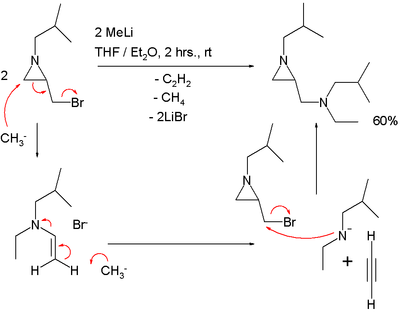Allylic rearrangement
An allylic rearrangement or allylic shift is an organic chemical reaction in which reaction at a center vicinal to a double bond causes the double bond to shift to an adjacent pair of atoms:

It is encountered in both nucleophilic and electrophilic substitution, although it is usually suppressed relative to non-allylic substitution. For example, reaction of 1-chloro-2-butene with sodium hydroxide gives 2-buten-1-ol and 3-buten-2-ol:

In the similar substitution of 1-chloro-3-methyl-2-butene, the secondary 2-methyl-3-buten-2-ol is produced in a yield of 85%, while that for the primary 3-methyl-2-buten-1-ol is 15%.
Allylic shifts occur because the transition state is an allyl intermediate. In other respects they are similar to classical nucleophilic substitution, and admit both bimolecular and monomolecular mechanisms (respectively the SN2' and SN1'/SNi' substitutions).
Scope
Allylic shifts become the dominant reaction pathway when there is substantial resistance to a normal (non-allylic) substitution. For nucleophilic substitution, such resistance is known when there is substantial steric hindrance at or around the leaving group, or if there is a geminal substituent destabilizing an accumulation of positive charge. The effects of substitution at the vinyl group are less clear.[1]
Although rarer still than SN', allylic shifts can occur vinylogously, as a "butadienylic shift":[2]
SN2' reduction
In SN2' reduction, a
The
Electrophilic allyl shifts
Allyl shifts can also take place with

The active catalyst system in this reaction is a combination of a
Examples
Repeated allylic shifts can "flip-flop" a double-bond between two possible locations:[5]

An SN2' reaction should explain the outcome of the reaction of an aziridine carrying a methylene bromide group with methyllithium:[6]
In this reaction one equivalent of acetylene is lost.
Named reactions
References
- ISBN 978-0-470-77104-4, retrieved 2024-03-10
- doi:10.1039/b616606g


